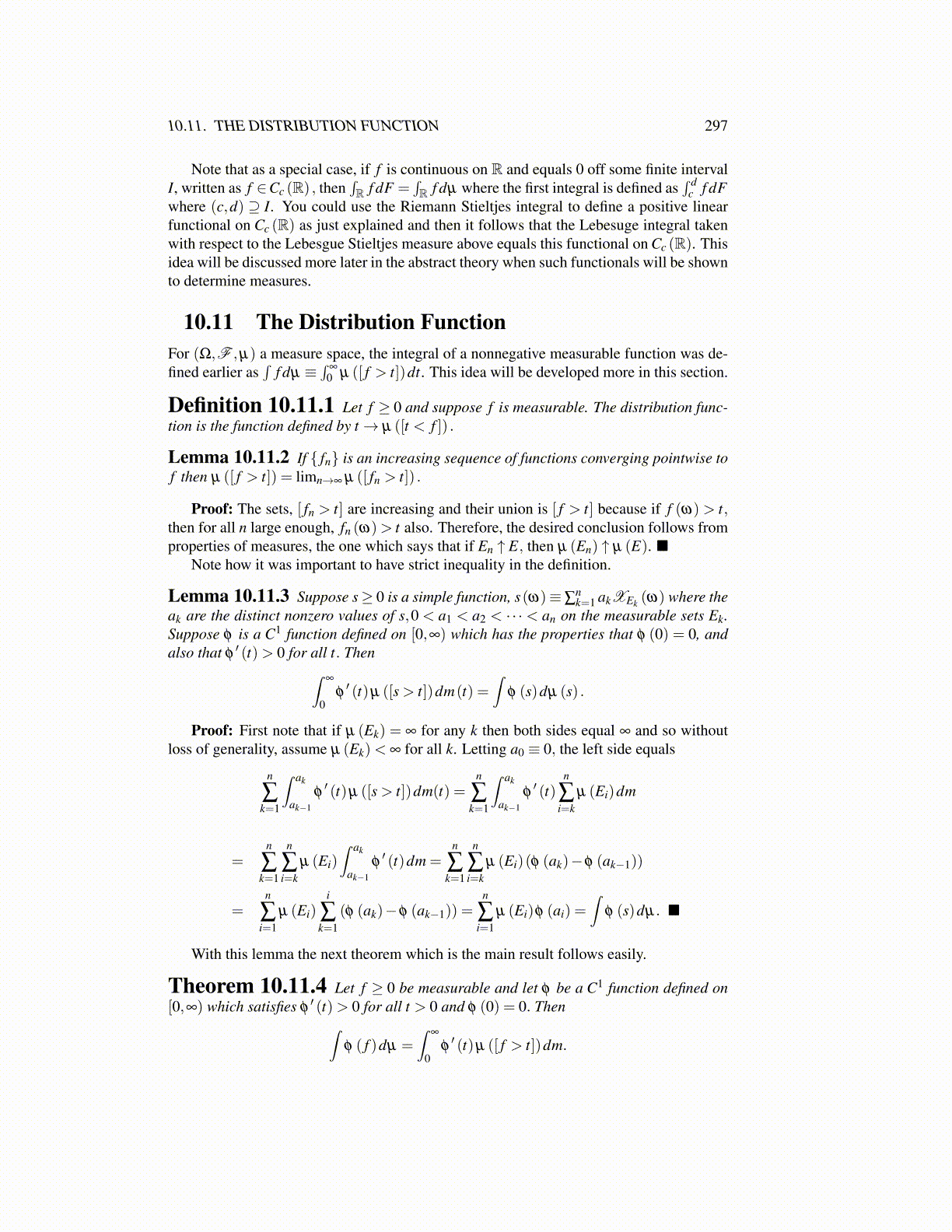
10.11. THE DISTRIBUTION FUNCTION 297
Note that as a special case, if f is continuous on R and equals 0 off some finite intervalI, written as f ∈Cc (R) , then
∫R f dF =
∫R f dµ where the first integral is defined as
∫ dc f dF
where (c,d) ⊇ I. You could use the Riemann Stieltjes integral to define a positive linearfunctional on Cc (R) as just explained and then it follows that the Lebesuge integral takenwith respect to the Lebesgue Stieltjes measure above equals this functional on Cc (R). Thisidea will be discussed more later in the abstract theory when such functionals will be shownto determine measures.
10.11 The Distribution FunctionFor (Ω,F ,µ) a measure space, the integral of a nonnegative measurable function was de-fined earlier as
∫f dµ ≡
∫∞
0 µ ([ f > t])dt. This idea will be developed more in this section.
Definition 10.11.1 Let f ≥ 0 and suppose f is measurable. The distribution func-tion is the function defined by t→ µ ([t < f ]) .
Lemma 10.11.2 If { fn} is an increasing sequence of functions converging pointwise tof then µ ([ f > t]) = limn→∞ µ ([ fn > t]) .
Proof: The sets, [ fn > t] are increasing and their union is [ f > t] because if f (ω) > t,then for all n large enough, fn (ω)> t also. Therefore, the desired conclusion follows fromproperties of measures, the one which says that if En ↑ E, then µ (En) ↑ µ (E). ■
Note how it was important to have strict inequality in the definition.
Lemma 10.11.3 Suppose s≥ 0 is a simple function, s(ω)≡∑nk=1 akXEk (ω) where the
ak are the distinct nonzero values of s,0 < a1 < a2 < · · · < an on the measurable sets Ek.Suppose φ is a C1 function defined on [0,∞) which has the properties that φ (0) = 0, andalso that φ
′ (t)> 0 for all t. Then∫∞
0φ′ (t)µ ([s > t])dm(t) =
∫φ (s)dµ (s) .
Proof: First note that if µ (Ek) = ∞ for any k then both sides equal ∞ and so withoutloss of generality, assume µ (Ek)< ∞ for all k. Letting a0 ≡ 0, the left side equals
n
∑k=1
∫ ak
ak−1
φ′ (t)µ ([s > t])dm(t) =
n
∑k=1
∫ ak
ak−1
φ′ (t)
n
∑i=k
µ (Ei)dm
=n
∑k=1
n
∑i=k
µ (Ei)∫ ak
ak−1
φ′ (t)dm =
n
∑k=1
n
∑i=k
µ (Ei)(φ (ak)−φ (ak−1))
=n
∑i=1
µ (Ei)i
∑k=1
(φ (ak)−φ (ak−1)) =n
∑i=1
µ (Ei)φ (ai) =∫
φ (s)dµ. ■
With this lemma the next theorem which is the main result follows easily.
Theorem 10.11.4 Let f ≥ 0 be measurable and let φ be a C1 function defined on[0,∞) which satisfies φ
′ (t)> 0 for all t > 0 and φ (0) = 0. Then∫φ ( f )dµ =
∫∞
0φ′ (t)µ ([ f > t])dm.